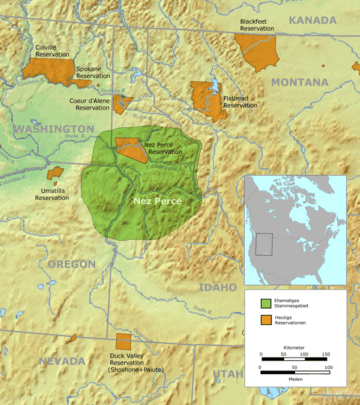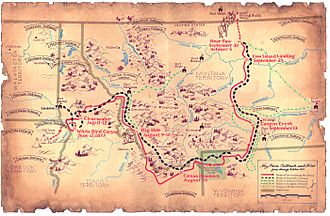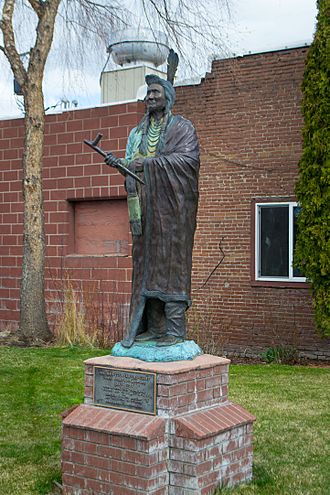Chief Joseph facts for kids
Quick facts for kids
Chief Joseph
|
|
|---|---|
| Hinmatóowyalahtq̓it | |
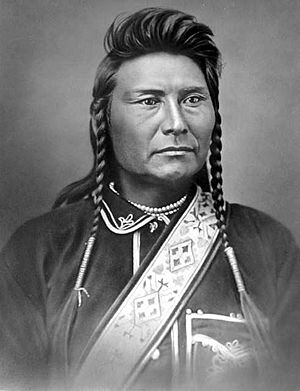
Chief Joseph in 1877
|
|
| Born | March 3, 1840 Wallowa Valley, Nez Perce territory (claimed as Oregon Country by the United States and as the Columbia District by the United Kingdom of Great Britain and Ireland)
|
| Died | September 21, 1904 (aged 64) Colville Indian Reservation, Washington, United States
|
| Resting place | Chief Joseph Cemetery Nespelem, Washington |
| Other names |
|
| Known for | Nez Perce leader |
| Predecessor | Joseph the Elder (father) |
| Spouse(s) |
|
| Children | Jean-Louise |
| Parent(s) |
|
| Relatives | Sousouquee (older brother), Ollokot (younger brother), four sisters |
| Signature | |
 |
|
Hinmatóowyalahtq̓it, also known as Chief Joseph, was an important leader of the Wal-lam-wat-kain band of the Nez Perce, a Native American tribe. He lived in the Pacific Northwest region of the United States in the late 1800s. Born on March 3, 1840, he became chief after his father, Tuekakas, passed away in the early 1870s.
Chief Joseph led his people during a very difficult time. The U.S. government forced his band to leave their traditional lands in the Wallowa Valley of northeastern Oregon. They were moved to a much smaller reservation in the Idaho Territory.
In 1877, some Nez Perce, including Joseph's band, resisted this move. They tried to escape the United States to find safety in Canada. They hoped to join the Lakota people led by Sitting Bull.
About 700 Nez Perce people, including men, women, and children, were led by Chief Joseph and other chiefs. The U.S. Army, led by General Oliver O. Howard, chased them. This chase became known as the Nez Perce War. The Nez Perce traveled about 1,170 miles, fighting bravely along the way. Their skill and courage earned them respect from their enemies and the American public.
In October 1877, after months of trying to escape, most of Joseph's band were trapped in northern Montana Territory. They were only about 40 miles from the Canadian border. Chief Joseph surrendered to the Army. He believed his people would be allowed to return to their reservation in Idaho. However, they were sent to different forts and reservations far away. Eventually, they were moved to the Colville Indian Reservation in Washington, where Chief Joseph died in 1904.
Chief Joseph's life is a famous part of the history of the American Indian Wars. He is remembered for his strong and peaceful resistance to his tribe being forced from their home. He became known as a humanitarian and a peacemaker.
Contents
Who Was Chief Joseph?
Chief Joseph was born Hinmuuttu-yalatlat, which means "Thunder Rolling Down the Mountain." He was born in the beautiful Wallowa Valley in northeastern Oregon. People called him Young Joseph because his father, Tuekakas, had the same Christian name and was known as "Old Joseph."
At first, Joseph the Elder was friendly with the white settlers who came to the region. But he became worried when they wanted more and more Native American lands. Settlers began taking traditional lands for farming and raising animals.
In 1855, Isaac Stevens, the governor of the Washington Territory, held a meeting. He wanted to set aside separate areas for Native Americans and settlers. Joseph the Elder and other Nez Perce chiefs signed the Treaty of Walla Walla. This treaty created a Nez Perce reservation of about 7.7 million acres. It included parts of present-day Idaho, Oregon, and Washington. This reservation kept most of the Nez Perce's traditional lands, including Joseph's Wallowa Valley. It is said that Joseph the Elder asked his son, Young Joseph, to protect their homeland and his father's burial place.
Changes to the Land Treaty
In 1863, many new settlers arrived because of a gold rush. This led the government to call a second meeting. Government officials asked the Nez Perce to accept a new, much smaller reservation. This new reservation was only about 760,000 acres. It was located around Lapwai, Idaho in western Idaho Territory and did not include the Wallowa Valley. In return, the Nez Perce were promised money, schools, and a hospital.
Chief Lawyer and one of his allied chiefs signed this new treaty. But Joseph the Elder and several other chiefs refused to sign. They did not want to sell their lands.
This refusal created a split among the Nez Perce. Some bands, called "treaty" Nez Perce, moved to the new reservation. Others, called "non-treaty" Nez Perce, stayed on their ancestral lands. Joseph the Elder marked the Wallowa land with poles. He declared, "Inside this boundary all our people were born. It circles the graves of our fathers, and we will never give up these graves to any man."
Chief Joseph's Leadership
Joseph the Younger became the leader of the Wallowa band in 1871, after his father died. Before his death, his father gave him important advice:
My son, my body is returning to my mother earth, and my spirit is going very soon to see the Great Spirit Chief. When I am gone, think of your country. You are the chief of these people. They look to you to guide them. Always remember that your father never sold his country. You must stop your ears whenever you are asked to sign a treaty selling your home. A few years more and white men will be all around you. They have their eyes on this land. My son, never forget my dying words. This country holds your father's body. Never sell the bones of your father and your mother.
Joseph later said, "I clasped my father's hand and promised to do as he asked. A man who would not defend his father's grave is worse than a wild beast."
The non-treaty Nez Perce faced many unfair actions from settlers and gold seekers. But Chief Joseph always tried to avoid violence. He feared what the powerful American military might do. He made many compromises, hoping to keep the peace. For example, in 1872, he peacefully told some settlers to leave land near Prairie Creek.

In 1873, Joseph tried to work with the U.S. government. He wanted his people to stay on their land in the Wallowa Valley. But in 1877, the government changed its mind. General Oliver O. Howard threatened to attack if Joseph's band did not move to the Idaho reservation. Joseph sadly agreed.
Before fighting began, General Howard held a meeting at Fort Lapwai. He wanted to convince Joseph and his people to move. Joseph spoke about human equality. He said he could not believe "the Great Spirit Chief gave one kind of men the right to tell another kind of men what they must do." Howard became angry, seeing this as a challenge to his power. When Toohoolhoolzote protested, he was jailed for five days.
The next day, Joseph, White Bird, and Looking Glass went with Howard to look at land on the reservation. Howard offered them land that already had white settlers and Native Americans living on it. He promised to remove the current residents. Joseph and his chiefs refused. Their tribal traditions taught them not to take what did not belong to them.
Since they could not find suitable empty land, Howard told Joseph his people had 30 days to move their livestock and themselves to the reservation. Joseph asked for more time, but Howard said that staying in the Wallowa Valley after 30 days would be an act of war.
Returning home, Joseph held a council with his people. He argued for peace, saying he would rather leave his father's grave than go to war. But Toohoolhoolzote, angry about being jailed, pushed for war. In June 1877, the Wallowa band began preparing for the move. They met with other bands at Rocky Canyon. Here, too, many leaders wanted war, but Joseph still argued for peace. While the council was happening, some young men, whose father had been killed, rode up. They announced they had killed four white settlers in revenge. Still hoping to avoid more bloodshed, Joseph and other non-treaty Nez Perce leaders began moving their people away from Idaho.
The Nez Perce War
The U.S. Army's pursuit of about 750 Nez Perce and a small group from the Palouse tribe became known as the Nez Perce War. Chief Joseph and other leaders led their people as they tried to escape from Idaho. At first, they hoped to find safety with the Crow Nation in the Montana Territory. But the Crow refused to help them. So, the Nez Perce headed north. They wanted to reach Canada and join the Lakota people led by Sitting Bull, who had fled there after the Great Sioux War in 1876.
Historians like Lucullus V. McWhorter argue that the Nez Perce were a peaceful people. They were forced into war when their land was taken. A Nez Perce warrior named Yellow Wolf said, "Our hearts have always been in the valley of the Wallowa."
For over three months, the Nez Perce skillfully avoided and fought their pursuers. They traveled more than 1,170 miles across what are now Oregon, Washington, Idaho, Wyoming, and Montana. One battle happened at White Bird Canyon on June 17, 1877. The Nez Perce fought off Captain Perry's U.S. Army cavalry. They killed 34 soldiers while only three Nez Perce were wounded.
The Nez Perce continued to resist the Army's attacks. They reached the Clearwater River, where they joined another Nez Perce chief, Looking Glass. This brought their group size to 740 people, though only 200 were warriors.
The final battle of the Nez Perce War took place near the Bears Paw Mountains in Montana. This was about 40 miles south of the Canadian border. A U.S. Army group led by General Nelson A. Miles found the Nez Perce on September 30 at the Battle of Bear Paw. After his first attacks failed, Miles broke a truce and captured Chief Joseph. However, he was later forced to trade Chief Joseph for one of his own captured officers.
General Howard arrived on October 3. He was impressed by how well the Nez Perce fought. They used advance guards, rear guards, and built defenses. After a harsh five-day siege in freezing weather, with no food or blankets, and with major war leaders dead, Chief Joseph officially surrendered on October 5, 1877.
Although Chief Joseph was not a war chief and likely didn't lead the fighting, his powerful surrender speech brought him much attention. He earned praise from General William Tecumseh Sherman and was called "The Red Napoleon" by newspapers. However, some historians argue that the Nez Perce's success in battle was due to the bravery of individual warriors, not Chief Joseph's military genius.
After the War
By the time Joseph surrendered, 150 of his followers had been killed or wounded. Their troubles were not over. Joseph had negotiated for his people to return home, but General Sherman changed this decision. Joseph and 400 followers were sent on unheated rail cars to Fort Leavenworth, Kansas. They were held there as prisoners of war for eight months. The next summer, the surviving Nez Perce were moved to a reservation in the Indian Territory (now Oklahoma). They lived there for seven years, and many died from diseases.
In 1879, Chief Joseph traveled to Washington, D.C. to meet with President Rutherford B. Hayes. He pleaded for his people to be allowed to return home. Joseph was respected as a speaker, but people in Idaho opposed his return. So, the U.S. government did not grant his wish to go back to the Pacific Northwest.
Finally, in 1885, Chief Joseph and his followers were allowed to return to the Pacific Northwest. They were meant to settle on the reservation near Kooskia, Idaho. Instead, Joseph and others were sent to the Colville Indian Reservation in Nespelem, Washington. This was far from their homeland in the Wallowa Valley and the rest of their people in Idaho.
Joseph continued to lead his Wallowa band on the Colville Reservation. Sometimes, he had disagreements with the leaders of the 11 other tribes also living there. Chief Moses of the Sinkiuse-Columbia tribe, for example, did not like giving up part of his people's land to Joseph's band.
In his later years, Joseph spoke strongly against the unfair policies of the United States government toward Native Americans. He hoped that America's promise of freedom and equality would one day include Native Americans too. In 1897, he visited Washington, D.C. again to make his case. He even rode with Buffalo Bill in a parade in New York City. People noticed his traditional headdress more than his important message.
In 1903, Chief Joseph visited Seattle, a growing city. He stayed at the Lincoln Hotel as a guest of Edmond Meany, a history professor. There, he also became friends with Edward Curtis, a famous photographer, who took one of his most well-known pictures. Joseph also visited President Theodore Roosevelt in Washington, D.C. that same year. Everywhere he went, he asked for his people to be returned to their home in the Wallowa Valley. But it never happened.
Chief Joseph's Death
Chief Joseph, a strong voice for justice, died on September 21, 1904. He was still in exile from his homeland. His doctor said he died "of a broken heart." Edmond Meany and Edward Curtis helped Joseph's family bury their chief near the village of Nespelem, Washington. Many members of his tribe still live there today.
Chief Joseph's Legacy
The Chief Joseph band of Nez Perce, who still live on the Colville Reservation, are named in his honor.
Memorials and Tributes
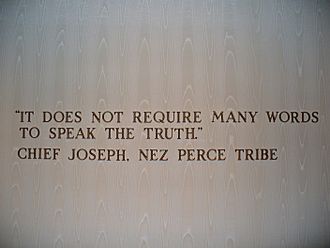
Many places and things are named after Chief Joseph:
- Chief Joseph Middle School in Richland, Washington.
- Chief Joseph Elementary School in Portland, Oregon.
- A statue of Young Chief Joseph in Enterprise, Oregon.
- A quote by Chief Joseph is displayed in The American Adventure at Walt Disney World's Epcot.
- Chief Joseph Pass in Montana.
- Chief Joseph Elementary School in Great Falls, Montana.
- The city of Joseph, Oregon, which hosts the Chief Joseph Days festival.
- Joseph Canyon, in Oregon and Washington.
- Joseph Creek, on the Oregon–Washington border.
- Chief Joseph Scenic Byway in Wyoming.
- Chief Joseph Dam on the Columbia River in Washington. This is the second-largest hydroelectric power producer in the U.S. and the only dam in the Northwest named after a Native American.
- Chief Joseph was featured on previously issued $200 Series I U.S. savings bonds.
- Chief Joseph Ranch in Montana is shown as the Dutton Ranch in the TV series Yellowstone.
Cultural Impact
Chief Joseph's story has inspired many works:
- The film I Will Fight No More Forever (1975) tells his story.
- The play Indians (1969-1970) featured Chief Joseph.
- Merrill Beal's book I Will Fight No More Forever: Chief Joseph and the Nez Perce War (2000) is a well-known account.
- Will Henry's novel From Where the Sun Now Stands (1959) portrays Chief Joseph.
- The children's book Thunder Rolling in the Mountains by Scott O'Dell tells his story from his daughter's view.
- Robert Penn Warren's poem "Chief Joseph of the Nez Perce" (1982) is about him.
- The band Rednex sampled his speech in their 2000 song The Spirit of the Hawk.
- In 2012, Chief Joseph's 1870s war shirt was sold for $877,500.
- In 1973, he was added to the Hall of Great Westerners at the National Cowboy & Western Heritage Museum.


